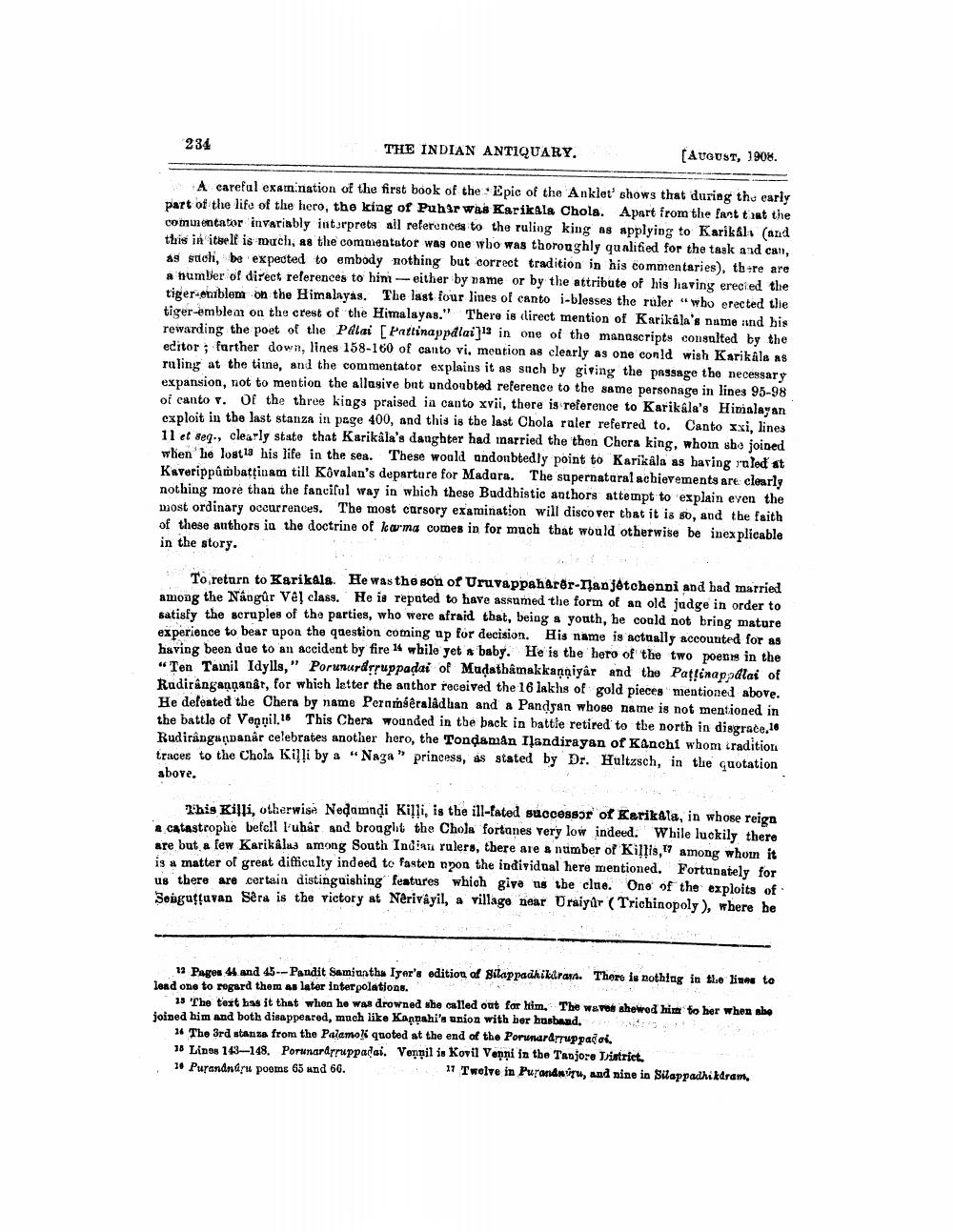________________
234
THE INDIAN ANTIQUARY.
(AUGUST, 1906.
A careful examination of the first book of the Epic of the Anklet' shows that during the early part of the life of the hero, the king of Puh3r was Karikala Chola. Apart from the fact test the commentator invariably interprete all references to the ruling king as applying to Karikák (and this is itself is much as the commentator was one who was thoroughly qualified for the task and can, as such, be expected to embody nothing but correct tradition in his commentaries), th-re are a number of direct references to him -- either by name or by the attribute of his having ereci ed the tiger-emblem on the Himalayas. The last four lines of canto i-blesses the ruler who erected the tiger-emblem on the crest of the Himalayas." There is direct mention of Karikala's name and his rewarding the poet of the Palai [Pattinappdlai]" in one of the manuscripts consulted by the editor ; farther down, lines 158-160 of canto vi, mention as clearly as one conld wish Karikáls as ruling at the time, and the commentator explains it as such by giving the passage the necessary expansion, not to mention the allasive bnt undoubted reference to the same personage in lines 95-98 of canto . Of the three kings praised in canto xvii, there is reference to Karikala's Himalayan exploit in the last stanza in page 400, and this is the last Chola raler referred to. Canto xxi, lines 11 et seq., clearly state that Karikala's daughter had married the then Chora king, whoin sho joined when he lost 18 his life in the sea. These would undonbtedly point to Karikâla as baring ruled at Kaverippûtibattinam till Kövalan's departure for Madara. The supernatural achievements are clearly nothing more than the fanciful way in which these Buddhistic anthors attempt to explain even the most ordinary occurrences. The most carsory examination will discover that it is so, and the faith of these authors in the doctrine of karma comes in for much that would otherwise be inexplicable in the story.
To return to Karikala. He was the son of Uruvappaharor-Ilanjótchendi and bad married among the Nángür Veļ class. He is reputed to have assumed the form of an old judge in order to satisfy the scruples of the parties, who were afraid that, being a youth, he could not bring mature experience to bear upon the question coming up for decision. His name is actually accounted for as having been due to an accident by fire 14 while yet & baby. He is the hero of the two poenis in the "Ten Tainil Idylls," Porunurdsruppadai of Mudathâmakkaņgiyâr and the Pattinapodlat of Rudirangannanât, for which letter the anthor received the 16 lakhs of gold pieces mentioned above. He defeated the Chera by name Peromseraládban and a Pandyan whose name is not mentioned in the battle of Vennil.16 This Chers wounded in the back in battle retired' to the north in disgrace.16 Rudirangapanâr celebrates another hero, the Tonqaman Ilandirayan of Kanchi whom tradition traces to the Chola Killi by a “Naza” princess, as stated by Dr. Hultzsch, in the quotation above.
his Killi, otherwise Nedamndi Killi, is the ill-fated successor of Kerikala, in whose reign a catastrophe befcll l'uhâr and broaght the Chola fortunes very low indeed. While luckily there are but a few Karikalus among South Indian rulers, there are a number of Killis, 7 among whom it is a matter of great difficalty indeed to fasten upon the individual here mentioned. Fortunately for us there are certain distinguishing features which give us the clue. One of the exploits of Senguttavan Séra is the victory at Nêrivayil, a village near Draiyur (Trichinopoly), where he
13 Pages 44 and 45--Pandit Saminatha Iyer's edition of Sikappadhikaran. There is nothing in the lines to lond one to rogard them as later interpolations.
13 The text has it that when he was drowned she called out for him. The waves showed him to her when she joined him and both disappeared, much like Kappahi's union with ber husband.
14 The 3rd stanza from the Palamos quoted at the end of the Porunardruppasok 18 Lino 113--148. Porunardrruppadai. Vennilis Kovil Vanni in the Tanjore District. 36 Purandndru pooms 65 und 66.
11 Twelve in Purandsuth, and nine in Silappadhikdram,




